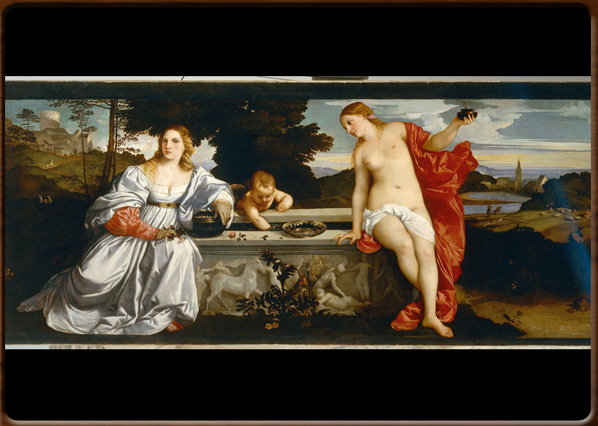
Girl with fruit platter.

La Flora. Tiziano, 1516-1520 ca, Florence, Galleria degli Uffizi.

Self-portrait. Tiziano, 1567, Museo Nacional del Prado.

Amor sacro e amor profano,. Tiziano, 1515, Galleria Borghese Rome.




No video
Tiziano Vecellio (Pieve di Cadore, in the province of Belluno, 1490-1576), known simply as “Titian”, was a major figure in the development of Venetian art. He moved to Venice at a very young age, an apprentice in Gentile Bellini’s workshop, though he soon became Giorgione’s pupil and assistant. He later learnt from the work of Andrea Mantegna, "Dürer and Raphael", thus developing a highly innovative realistic style for the Venice of the day, as seen in his Sacred and profane Love (1515, Galleria Borghese, Rome) and Our Lady of the Assumption altarpiece (1518, Santa Maria Gloriosa dei Frari, Venice).
Still later, he worked for several Italian courts in Ferrara, Mantua and Urbino. In 1530, he became court artist for the Emperor Charles V, producing a plethora of mythological scenes ("Venus of Urbino", 1538, Gallerie degli Uffizi, Florence; "The Bacchanal of the Gods" 1523-24, Museo Nacional del Prado, Madrid) and portraits ("Man with Gloves", 1523, Musee du Louvre, Paris; "La Bella", 1536, Palazzo Pitti, Florence).
At the same time he continued to produce altarpieces in a realistic style, such as his "Pala Pesaro" (1519-26, Santa Maria Gloriosa dei Frari, Venice).
In 1540 or so, Titian adopted a new highly dramatic and emotional style of figurative art, especially during his stay in Rome (1545-46). Works from this period include his "Ecce Homo" (1543) in Vienna. Titian started to delve deeper into the psychology of his portraits, as seen in his "Clarice Strozzi aged five" (1542) in the Staatliche Museen, Berlino and his "The Young Englishman" in Palazzo Pitti, Florence.
In 1548 he accompanied Charles V to the "Diet of Augsburg" (Portrait of Charles V on Horseback, 1548, Museo Nacional del Prado, Madrid). Titian’s work in Venice consisted mainly of religious altarpieces, such as his "The Martyrdom of St. Lorenzo" (1559, Chiesa dei Gesuiti). He produced several masterpieces towards the end of his life, including two still in Venice: "The Annunciation" (Church of San Salvatore) and "Pietà" (1570-76, Gallerie dell’Accademia).
Titian is famed for his extreme use of colours, creating a new language that greatly influenced the likes of Tintoretto, Rembrandt, Rubens, El Greco and many other Great Masters over the centuries.
1500 - - rev. 0.1.5